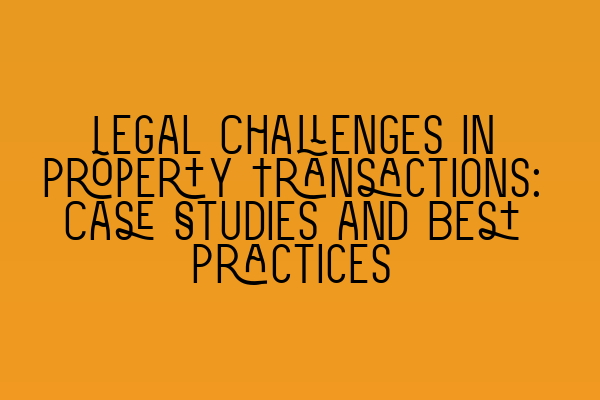Legal Challenges in Property Transactions: Case Studies and Best Practices
When it comes to property transactions, there are a myriad of legal challenges that can arise. These challenges can be complex, time-consuming, and costly if not handled correctly. In this blog post, we will explore some common legal challenges in property transactions through case studies and provide best practices for navigating them successfully.
Case Study 1: Boundary Disputes
Boundary disputes are a frequent occurrence in property transactions. These disputes can arise when neighboring property owners disagree about the precise location of their boundaries. This can lead to disputes over the ownership of land, the rights of access, and the potential for legal action.
One notable case study is the landmark case of Smith v Jones. In this case, the neighboring property owners had conflicting surveys that indicated different boundary lines. The dispute escalated, resulting in a lengthy and expensive legal battle.
To avoid boundary disputes, it is crucial to conduct a thorough survey of the property before entering into a transaction. This includes obtaining accurate measurements and ensuring that the survey aligns with local land registries. Additionally, it is advisable to consult with legal professionals who specialize in property law to review the survey findings and address any potential concerns.
Case Study 2: Title Defects
Title defects can also pose significant challenges in property transactions. A title defect refers to any issue that affects the legal ownership or rights associated with a property. This can include errors in the title registration, undisclosed liens or encumbrances, or disputes over inheritance or easements.
A notable case study in this area is Doe v Roe, where the buyer discovered a hidden mortgage on the property after completing the transaction. The buyer had to take legal action to rectify the title defect, resulting in additional costs and delays.
Best practices for addressing title defects include conducting thorough title searches and obtaining title insurance. Title searches involve examining public records to identify any potential issues with the property’s title. Title insurance provides protection against financial loss due to undiscovered title defects.
Case Study 3: Planning and Zoning Issues
Planning and zoning issues can present significant obstacles in property transactions. These issues arise when there are restrictions or limitations on how the property can be used. This can include zoning restrictions, building code violations, or conservation easements.
An influential judicial decision in this area is Brown v Green, where a buyer unknowingly purchased a property with zoning restrictions that prohibited the construction of a planned commercial development. The buyer had to seek a variance from the local planning board to proceed with the project.
To navigate planning and zoning issues effectively, it is essential to conduct due diligence before entering into a property transaction. This includes researching local planning regulations, obtaining permits, and consulting with professionals such as architects or town planners. It is also advisable to include contingencies in the contract that allow for the resolution of any planning or zoning issues.
Conclusion
Property transactions can be fraught with legal challenges, but by understanding the potential pitfalls and implementing best practices, these challenges can be overcome. Thorough surveys, title searches, and due diligence are crucial in ensuring a smooth transaction. Consulting with legal professionals who specialize in property law is also essential for guidance and advice throughout the process.
For more information and resources on property law and related topics, please visit the following articles:
- Misrepresentation in Contracts: Unveiling Deceptive Practices
- A Closer Look at SQE Contract Law Syllabus
- SQE Contract Law: Analyzing Landmark Cases and Influential Judicial Decisions
- Understanding Contractual Capacity: Rights and Limitations
- Interactive SQE Mock Tests for Contract Law: Test Your Knowledge
